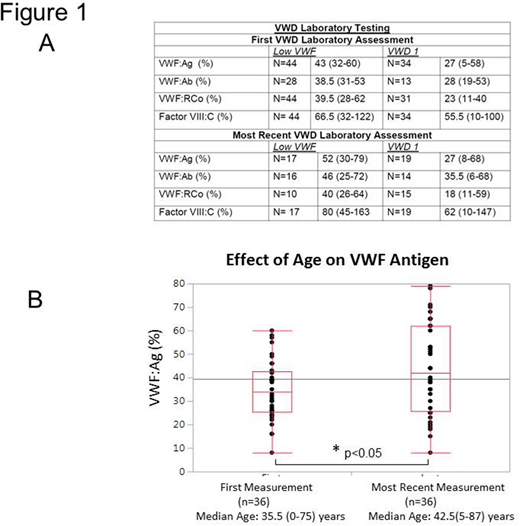Abstract
Introduction
Type 1 von Willebrand disease (VWD 1) accounts for ~75% of VWD. The National Heart, Lung, and Blood (NHLBI) VWD guidelines recommend VWF:Ag and VWF:RCo cut-off levels of <30 (IU/dL or %) for definite laboratory diagnosis of VWD 1. However, guidelines indicate that patients with "low VWF" (VWF:Ag and VWF:RCo in the 30-50 IU/dl range) could be candidates for agents to increase VWF levels if they are at risk for bleeding. Here we examine the diagnostic practices for VWD at Mayo Clinic Rochester by determining the proportion of patient currently classified as VWD 1 that meet NHLBI criteria for "low VWF". In addition, we assess changes in the laboratory phenotype of the aging population of patients with "low VWF" and VWD 1.
Methods
Patients with a diagnosis of VWD 1 at our institution were identified through our institutional hemophilia treatment center database (1986 to 2017). All available VWF:Ag and VWF activity (ristocetin cofactor assay [VWF:RCo] and latex immuno-activity assay [VWF:Ab]) levels performed at our institution and available in our electronic medical record (EMR) were recorded. Exclusion criteria included confounding variables known to effect VWF levels (eg,. hormonal therapy, pregnancy, desmopressin, or VWF/VIII concentrate administration) at the time of first laboratory assessment (VWF:Ag and VWF activity (by either VWF:Ab or VWF: RCo) at our institution. Bleeding score, retrospectively assessed using the MCMDM-1 VWD bleeding assessment tool (BAT), at the time of first clinical evaluation was recorded if enough information was available in the EMR. All VWF testing was recorded for comparative analysis between the first and the most recent measurements within the study period. Patients were not included in age-related analysis if the most recent laboratory values were obtained in the presence of the confounding variables noted above. Statistical analysis was performed using JMPfor paired t-tests and STATA for multilevel mixed-effects regression analysis.
Results
78 patients (50 F) met study criteria. Median age at initial presentation at our institution was 27.5 (0-75) years. Medians (ranges) for VWF:Ag (n=78), VWF:Ab (n=41), and VWF:RCo (n=75) were 39 (5-60)%, 37 (19-53)%, and 36 (11-62)%, respectively (reference ranges 55-200% for VWF and factor VIII values). Coagulation factor VIII activity (FVIII:C) was 63 (10-122)% (n=78). Of 37 patient with available blood type results, 23 (62%) were blood group O. 56% of patients (n=44) met NHLBI criteria for classification as "low VWF" (Figure 1, Panel A). There was no difference in bleeding score between patients with VWD 1 (median bleeding score: 4 (0-14), n=22) compared to those with "low VWF" (median bleeding score: 4 (0-14), n=37).
54 patients had repeat laboratory testing at 4.5 (0-29) years after initial testing. VWF antigen and activity levels were compared in those who had repeat testing done >1 year (n=36) after initial lab testing at our institution. Median age of patients at time of most recent measurement was 42.5 (5-87) years compared to 35.5 (0-75) years at first measurement. VWF:Ag was significantly higher in the most recent measurement compared to the first measurement (p< 0.05, Figure 1, Panel B ). There was no statistically significant difference between VWF activity levels in the first versus the most recent measurement.
There was a non-significant trend towards increasing VWF:Ag with increasing age; however when stratified into "low VWF" and VWD 1 disease groups, there was a significant relationship between VWF Ag and age in the "low VWF" group with mixed effects regression model (coefficient: 0.207, p:0.043).
Conclusion
Approximately 55% of patients with a clinical diagnosis for VWD 1 meet criteria for "low VWF." In our cohort, there was no difference in bleeding (BAT) scores between the two groups; however our analysis is limited by its retrospective nature. We also demonstrate a statistically significant increase in VWF:Ag with aging; however, with regression analysis, this change was only noted in those in the "low VWF" group. Larger prospective studies controlling for confounding factors are needed to further demonstrate the effect of age on VWF antigen and activity levels.
No relevant conflicts of interest to declare.
Author notes
Asterisk with author names denotes non-ASH members.


This feature is available to Subscribers Only
Sign In or Create an Account Close Modal